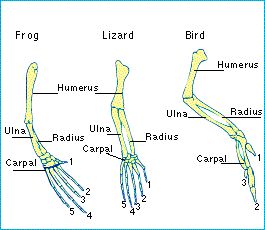Homologies

A homology is a character shared between species that was also present in their common ancestor.
This can be contrasted with an homoplasy, which is a convergent character shared between species but not present in their common ancestor.
Homologies are divided into derived homologies and ancestral homologies: a derived homology is one that is unique to a particular group of species (and their ancestor) and an ancestral homology is one that is found in the ancestor of a group of species and some, but not necessarily all, of its descendants.
The word homology has also been used in other senses. For example, before the theory of evolution was developed, homology referred to deep similarities of characters between species, as opposed to more superficial similarities called homoplasies.
An animation illustrates how the pentadactyl limb structure is a homology.
Figure: all tetrapods have a basic pentadactyl (five-digit) limb structure. The fore limbs of a frog, lizard and bird are all constructed from the same bones even though they perform different functions.
| Next |



